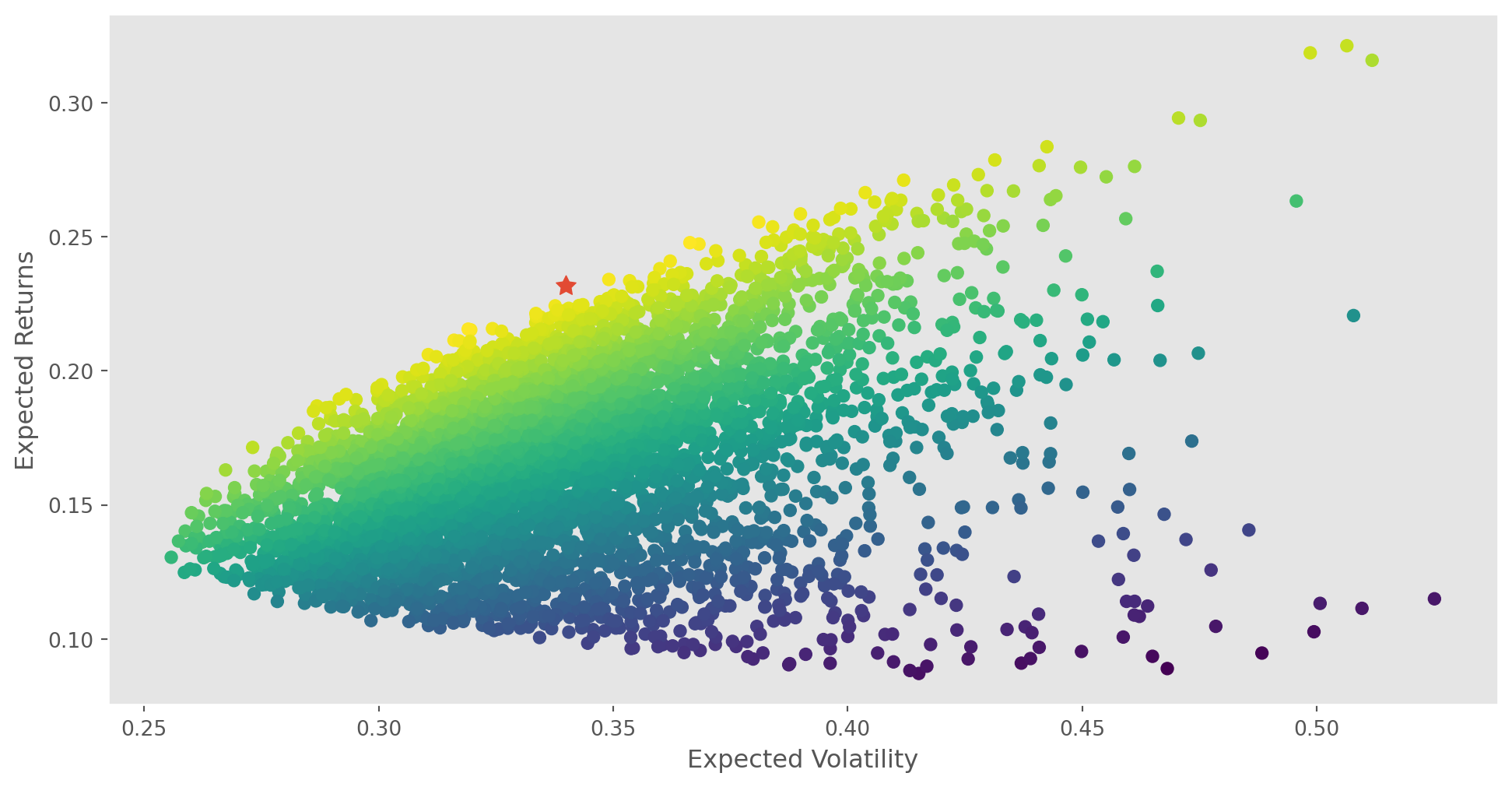import numpy as np
import matplotlib.pyplot as plt
import scipy as sp
import pandas as pd
import datetime as dt
import numpy_financial as npf
import yfinance as yf
from scipy.optimize import minimize
plt.style.use("ggplot")Bond Valuation
Here is a general logic of Bond Valuation: Adding up all present values of expected cash flows to equal the par value of the security.
Three procedures: 1. Estimate the cash flow (It’s simple if you hold treasury bills or bonds, because they are fixed. It’s way much more complicated for structured products like Mortgage-Backed Securities) 2. Which discount rate to use? (Require return = risk-free rate + risk premium) 3. Calculate the present values of all cash flows.
Zero Coupon Bond
Zero coupon bond returns you principal amount (face value) after certain period of time, no other cash payment is made.
The most common zero coupon bond is US treasury bill, you buy the bill with a discounted price, for instance the par value is \(\$1000\), you pay \(\$950\) today and receives the par value \(\$1000\) one year later.
In reality, treasury bills has different maturities, such as 4 week, 8 weeks or the longest 52 weeks.
class ZeroCouponBonds:
def __init__(self, principal, maturity, discount_rate):
self.principal = principal
self.maturity = maturity # date to maturity
self.discount_rate = discount_rate # risk-free interest rate
def calculate_pv(self):
return self.principal / (1 + self.discount_rate) ** self.maturitybond = ZeroCouponBonds(1000, 3, 0.04)bond.calculate_pv()888.9963586709148discount_rate_array = np.linspace(0.01, 0.1)
pv_array = []
for i in discount_rate_array:
pv_array.append(ZeroCouponBonds(1000, 3, i).calculate_pv())fig, ax = plt.subplots(figsize=(12, 6))
ax.plot(discount_rate_array, pv_array)
ax.set_title("$\$1000$ zero-coupon bond price")
ax.set_xlabel("discount rate")
plt.show()
Coupon Bond
Coupon bonds are the one paying regular coupons till maturity. The pricing formula is
\[ P= \sum_{t=1}^n \frac{C_t}{(1+r)^t}+\frac{B}{(1+r)^n} \]
where \(C\) is coupon, B is the par value, n is the maturity.
3 year maturity, coupon rate \(10\%\), annual payment, par value \(\$1000\), discount rate (YTM) is \(4\%\).
class CouponBond:
def __init__(self, principal, coupon_rate, maturity, discount_rate):
self.principal = principal
self.coupon_rate = coupon_rate
self.maturity = maturity
self.discount_rate = discount_rate
def calculate_pv(self, x, n):
return x / (1 + self.discount_rate) ** n
def calculate_bond_price(self):
price = 0
for t in range(1, self.maturity + 1):
price = price + self.calculate_pv(self.principal * self.coupon_rate, t)
price = price + self.calculate_pv(self.principal, self.maturity)
return pricebond = CouponBond(1000, 0.1, 3, 0.08)bond.calculate_bond_price()1051.5419397449573discount_rate_array = np.linspace(0.01, 0.15)
pv_array = []
for i in discount_rate_array:
pv_array.append(CouponBond(1000, 0.1, 3, i).calculate_bond_price())fig, ax = plt.subplots(figsize=(12, 6))
ax.plot(discount_rate_array, pv_array)
ax.set_title("$\$1000$ coupon bond price")
ax.set_xlabel("discount rate")
ax.scatter(0.1, 1000, s=100)
plt.show()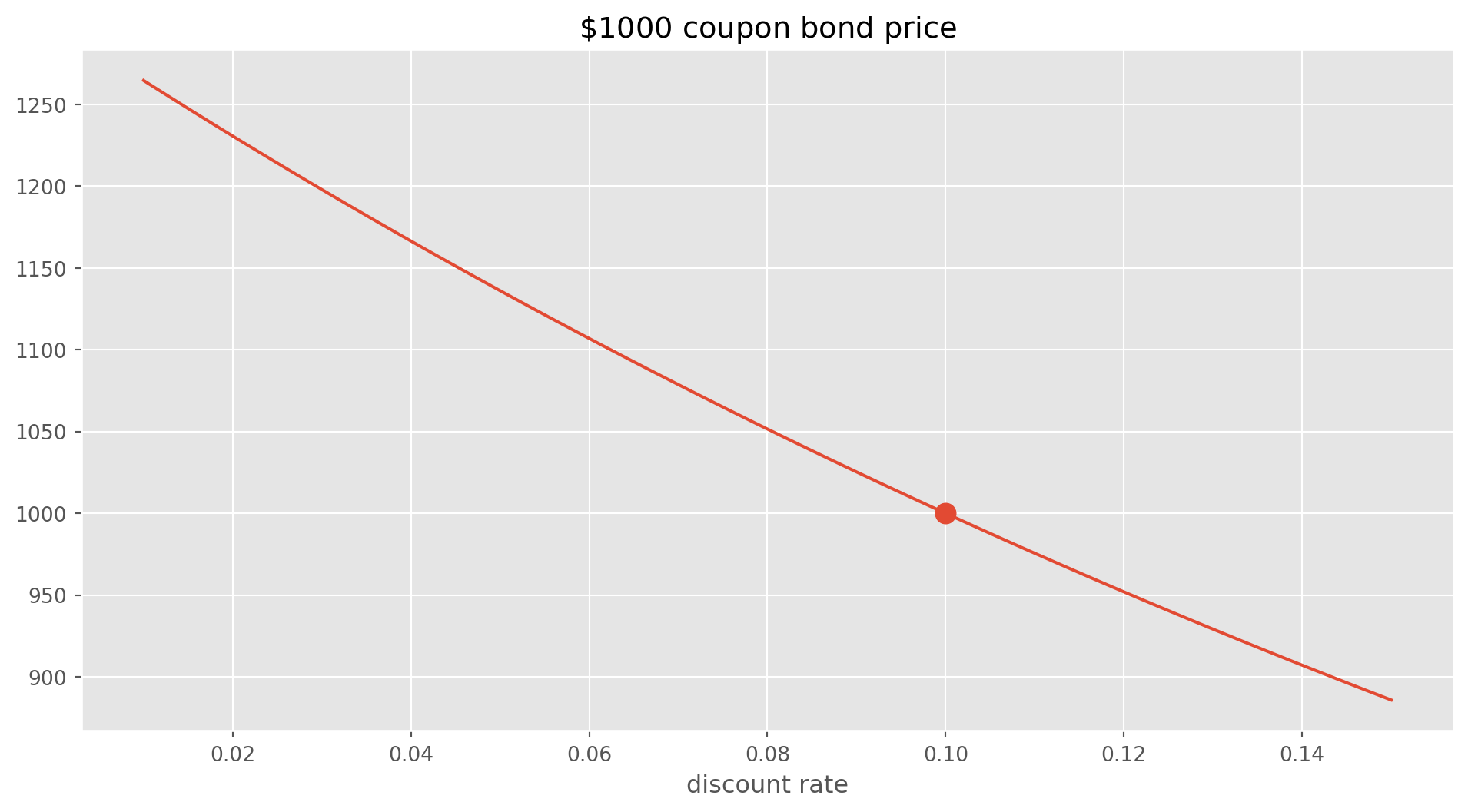
From the chart, we know that if discount rate equals coupon rate, in this case \(10\%\), it’s called par bond. If the price is larger than face value, it is premium bond, vice verse discount bond.
Portfolio Management
If you are not a single asset trader, you will end up constructing your portfolio sooner or later. In the view of portfolio management, the risk of single type of asset is not a major concern anymore, rather the risk of portfolio, e.g. you might need to consider have derivatives in your portfolios too.
- Planning
- State your investment objectives and constraints. (Institutions usually use Investment Policy Statement)
- Review your objective benchmark regularly
- Execution
- Asset allocation
- Security Analysis
- Portfolio construction
- Feedback
- Monitor and rebalance portfolio
- Measure portfolio performance
Performance Measuring
Two methods of measuring portfolio’s performance.
Time-Weight Rate of Return
Basically it’s annualized geometric mean.
Suppose you hold a portfolio for 3 years, at the end of first year the return is 12%, second year 2%, third year 7%.
The geometric mean function can return a TWRR directly, if the holding period is long than 1 year.
sp.stats.gmean([12, 2, 7])5.517848352762241Now suppose you hold a portfolio for 1 year, at the end of first season the return is 1%, the second season 4%, the third season -5%, the forth season 8%.
np.prod([1.01, 1.04, 0.95, 1.08]) - 10.07771039999999996The general formula is \[ \text{TWRR} = \left[\prod_{i=1}^N(1+\text{HPR}_i)\right]^{1/n}-1 \]
TWRR measures the compound rate of return, where \(n\) is number of years, \(N\) the number of periods, \(\text{HPR}\) means holding period return.
As a reminder, for audiences familiar with another measurement Compound Annual Growth Rate \(\text{CAGR}\) \[
C A G R=\left[\left(\frac{E V}{B V}\right)^{1/n}-1\right]\times 100
\] where: \(E V=\) Ending value
\(B V=\) Beginning value
\(n=\) Number of years
Both are geometric means, but \(\text{TWRR}\) measures returns of every period.
Example of TWRR
You bought a share of a mutual fund for \(\$100\) at \(t=0\), another share at \(\$113\) at \(t=1\), also you receive dividend \(\$4\) at \(t=1\), \(\$7\) at \(t=2\) per share.Then you redeem both shares for \(\$120\) at \(t=2\).
Calculate TWRR.
fund = {"price": [100, 113, 120], "dividend": [0, 4, 7]}
fund = pd.DataFrame(fund)
fund| price | dividend | |
|---|---|---|
| 0 | 100 | 0 |
| 1 | 113 | 4 |
| 2 | 120 | 7 |
HPR_1 = (113 + 4) / 100 - 1
HPR_2 = (120 * 2 + 7 * 2) / (113 * 2) - 1np.sqrt((1 + HPR_1) * (1 + HPR_2)) - 10.14671520100345292Money-Weight Rate of Return
Basically annualized IRR.
Example of MWRR
You bought a share of a mutual fund for \(\$100\) at \(t=0\), another share at \(\$113\) at \(t=1\), also you receive dividend \(\$4\) at \(t=1\), \(\$7\) at \(t=2\) per share.Then you redeem both shares for \(\$120\) at \(t=2\).
Calculate MWRR.
The key of MWRR is to identify net cash flow for each period, then calculate IRR.
npf.irr([-100, -113 + 4, 120 * 2 + 7 * 2])0.1393470544991613To summarize, MWRR takes account of cash flow, TWRR does not.
Modern Portfolio Theory
MPT states that investors can construct optimal portfolios offering maximum possible expected return for a given risk level.
Assumption: 1. Return of assets are normally distributed. 2. Investors are risk-averse. (Higher return, higher risks.) 3. Investors are only long positions only.
Efficiency Frontier
Definition of Portfolio Return and Volatility
Commonly the MPT is illustrated by matrices. Define \(\mathbf{R}\) and \(\mathbf{w}\)
\[ \mathbf{R}=\left[\begin{array}{c} R_1 \\ R_2 \\ R_3 \end{array}\right], \quad \mathbf{w}=\left[\begin{array}{l} w_1 \\ w_2 \\ w_3 \end{array}\right] \] where \(R_i\) represents the return of asset \(i\); \(w_i\) the weight of asset \(i\)
The expected return and covariance matrix of return is \[ E[\mathbf{R}]=\left[\begin{array}{l} E\left[R_1\right] \\ E\left[R_2\right] \\ E\left[R_3\right] \end{array}\right]=\left[\begin{array}{c} \mu_1 \\ \mu_2 \\ \mu_3 \end{array}\right]=\boldsymbol{\mu} \]
\[ \begin{aligned} \operatorname{var}(\mathbf{R}) & =\left[\begin{array}{ccc} \operatorname{var}\left(R_1\right) & \operatorname{cov}\left(R_1, R_2\right) & \operatorname{cov}\left(R_1, R_3\right) \\ \operatorname{cov}\left(R_2, R_1\right) & \operatorname{var}\left(R_2\right) & \operatorname{cov}\left(R_2, R_3\right) \\ \operatorname{cov}\left(R_3, R_1\right) & \operatorname{cov}\left(R_3, R_2\right) & \operatorname{var}\left(R_3\right) \end{array}\right] \\ & =\left[\begin{array}{ccc} \sigma_1^2 & \sigma_{1, 2} & \sigma_{1, 3} \\ \sigma_{1,2} & \sigma_2^2 & \sigma_{2,3} \\ \sigma_{1,3} & \sigma_{2,3} & \sigma_3^2 \end{array}\right]=\mathbf{\Sigma} \end{aligned} \]
The portfolio return is obtained by inner product of \(\mathbf{w}\) and \(\mathbf{R}\)
\[ R_{p}=\mathbf{x}^{T} \mathbf{R}=\left[w_1, w_2, w_3\right]\left[\begin{array}{c} R_A \\ R_B \\ R_C \end{array}\right]=x_1 R_1+x_2 R_2+x_3 R_3 \] where \(R_p\) represents portfolio return. Similarly, the expected portfolio return is \[ w_1 \mu_1+w_2 \mu_2+w_3 \mu_3 \]
The variance of the portfolio is \[ \sigma_{p}^2=\operatorname{var}\left[\mathbf{w}^{T} \mathbf{R}\right]=\mathbf{w}^{T} \Sigma \mathbf{w}=\left[x_1, x_2, x_3\right]\left[\begin{array}{ccc} \sigma_1^2 & \sigma_{1,2} & \sigma_{1,3} \\ \sigma_{1,2} & \sigma_2^2 & \sigma_{2,3} \\ \sigma_{1,3} & \sigma_{2,3} & \sigma_3^2 \end{array}\right]\left[\begin{array}{l} x_1 \\ x_2 \\ x_3 \end{array}\right] \]
This is a standard quadratic form, for more details, check quadratic form and multivariate normal distribution.
Retrieve Data
stocks = ["AMZN", "HD", "MRNA", "TSLA", "LULU"]
start_date = "2015-01-01"
end_date = dt.datetime.today()def download_data(stocks, dropna):
# dropna decides if you want to drop all NaN values
stock_data = {}
for stock in stocks:
ticker = yf.Ticker(stock)
stock_data[stock] = ticker.history(start=start_date, end=end_date)["Close"]
if dropna == True:
df = pd.DataFrame(stock_data).dropna()
else:
df = pd.DataFrame(stock_data)
return dfdf = download_data(stocks, dropna=True)
df.head()| AMZN | HD | MRNA | TSLA | LULU | |
|---|---|---|---|---|---|
| Date | |||||
| 2018-12-07 00:00:00-05:00 | 81.456497 | 147.259521 | 18.600000 | 23.864668 | 113.870003 |
| 2018-12-10 00:00:00-05:00 | 82.051498 | 146.322021 | 18.799999 | 24.343332 | 115.010002 |
| 2018-12-11 00:00:00-05:00 | 82.162003 | 146.765259 | 18.010000 | 24.450666 | 116.849998 |
| 2018-12-12 00:00:00-05:00 | 83.177002 | 148.469711 | 18.680000 | 24.440001 | 122.650002 |
| 2018-12-13 00:00:00-05:00 | 82.918999 | 148.179932 | 18.760000 | 25.119333 | 120.199997 |
def plot_data(size, data, title):
# choose the size of the figure [w, h]
data.plot(figsize=(size[0], size[1]), title=title)
plt.show()plot_data([12, 6], df, title="Close Price Plot")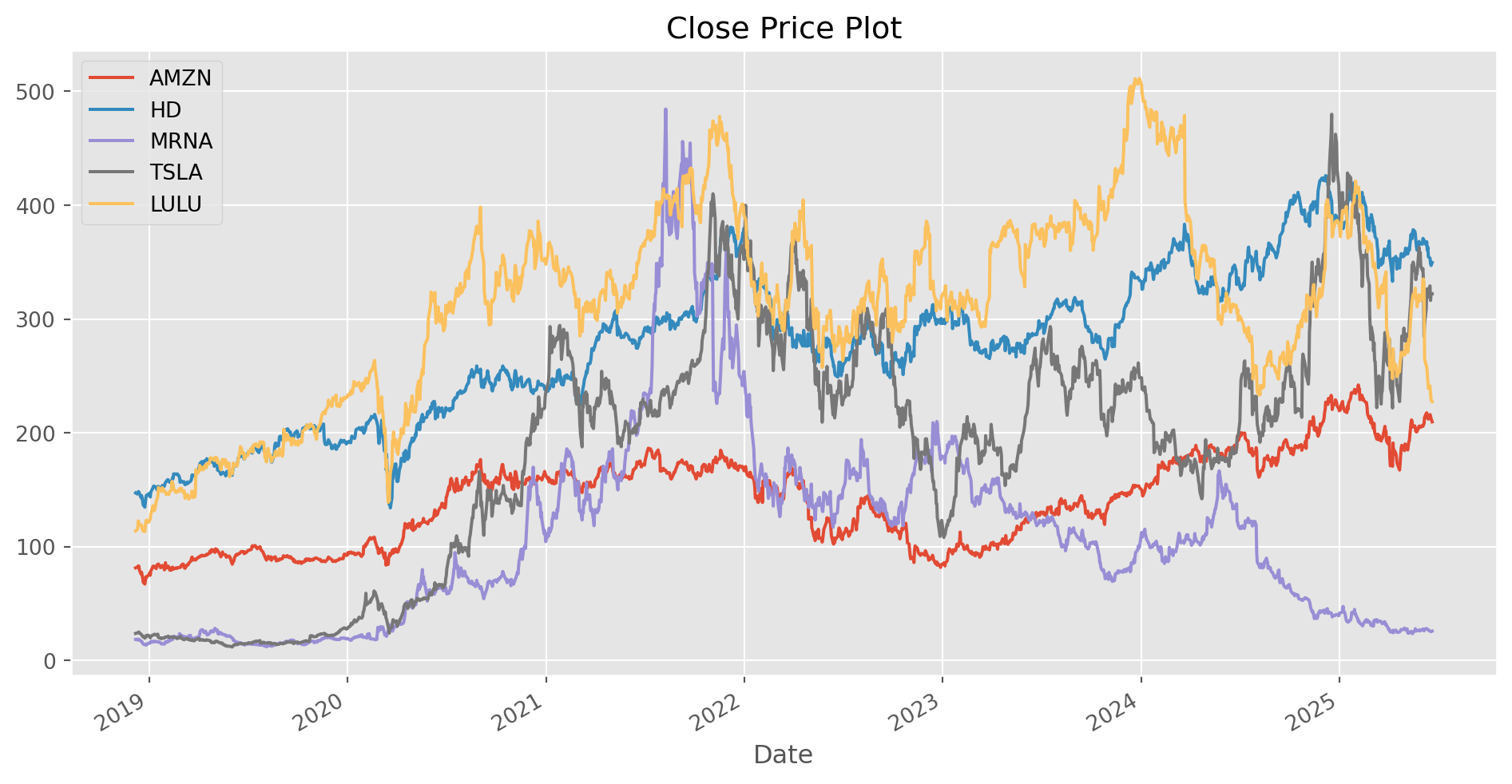
def cal_log_return(data):
return (np.log(data) - np.log(data.shift())).dropna()log_ret_daily = cal_log_return(df)plot_data([12, 6], log_ret_daily, title="Log Return Plot")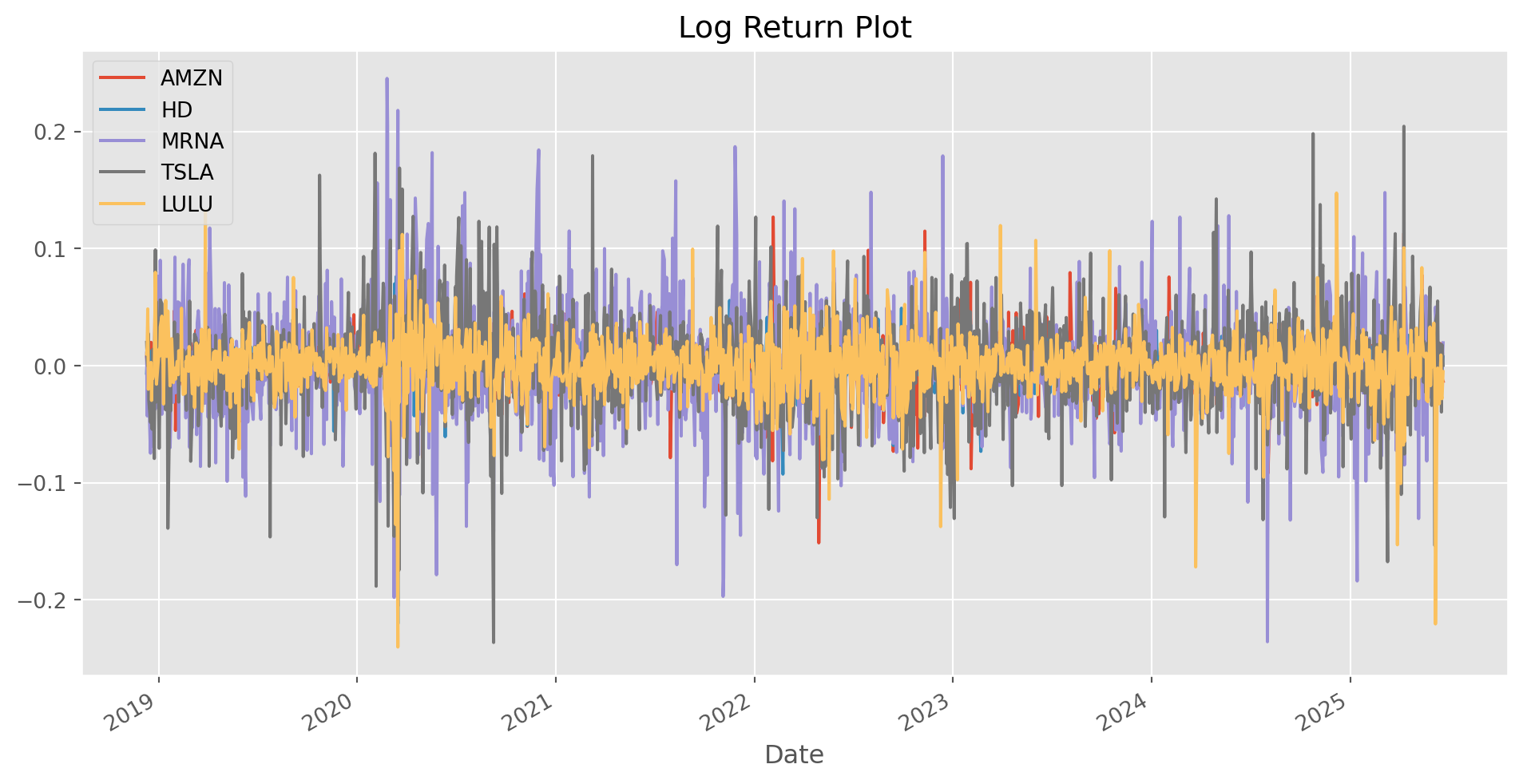
Calculate Expected Return and Volatility
# assume the average trading days in a year is 252
num_trading_days = 252def cal_statistics(returns):
# mean of annual return
print(returns.mean() * num_trading_days)cal_statistics(log_ret_daily)AMZN 0.145205
HD 0.132780
MRNA 0.050842
TSLA 0.399676
LULU 0.106261
dtype: float64weights = np.array([0.2, 0.1, 0.4, 0.1, 0.1])\[ \mu = \sum_i w_i \mu_i \] where \(\mu\) is expected portfolio return, \(w\) is the weight, \(\mu_i\) is the expected rate of return on a specific asset.
\[ \mathbf{w}^{T} \Sigma \mathbf{w} \]
def show_mean_var(returns, weights):
portfolio_return = np.sum(returns.mean() * weights) * num_trading_days
portfolio_volatility = np.dot(
weights.T, np.dot(returns.cov() * num_trading_days, weights)
)
print("portfolio return: {}".format(portfolio_return))
print("portfolio volatility: {}".format(portfolio_volatility))
return portfolio_return, portfolio_volatilityshow_mean_var(log_ret_daily, weights)portfolio return: 0.11324963347558487
portfolio volatility: 0.1275179090538697(0.11324963347558487, 0.1275179090538697)Simulate Portfolios
num_portfolio = 5000
def gen_portfolio(returns, stocks):
portfolio_weights = []
portfolio_means = []
portfolio_volatilities = []
for i in range(num_portfolio):
w = np.random.rand(len(stocks))
w = w / np.sum(w)
portfolio_weights.append(w)
portfolio_means.append(np.sum(returns.mean() * w) * num_trading_days)
portfolio_volatilities.append(
np.sqrt(np.dot(w.T, np.dot(returns.cov() * num_trading_days, w)))
)
return (
np.array(portfolio_weights),
np.array(portfolio_means),
np.array(portfolio_volatilities),
)portfolio_weights, portfolio_means, portfolio_volatilities = gen_portfolio(
log_ret_daily, stocks
)plt.rcParams["axes.grid"] = (
False # this is unnecessary, but without it, a bug warning will be triggered
)
def portfolio_scatter(returns, volatilities):
fig, ax = plt.subplots(figsize=(12, 6))
mpt = ax.scatter(
volatilities, returns, c=returns / volatilities
) # actually we didn't use risk-free rate as reference for SR
ax.set_xlabel("Expected Volatilities")
ax.set_ylabel("Expected Returns")
ax.grid()
fig.colorbar(mpt, label="Sharpe Ratio")
plt.show()portfolio_scatter(portfolio_means, portfolio_volatilities)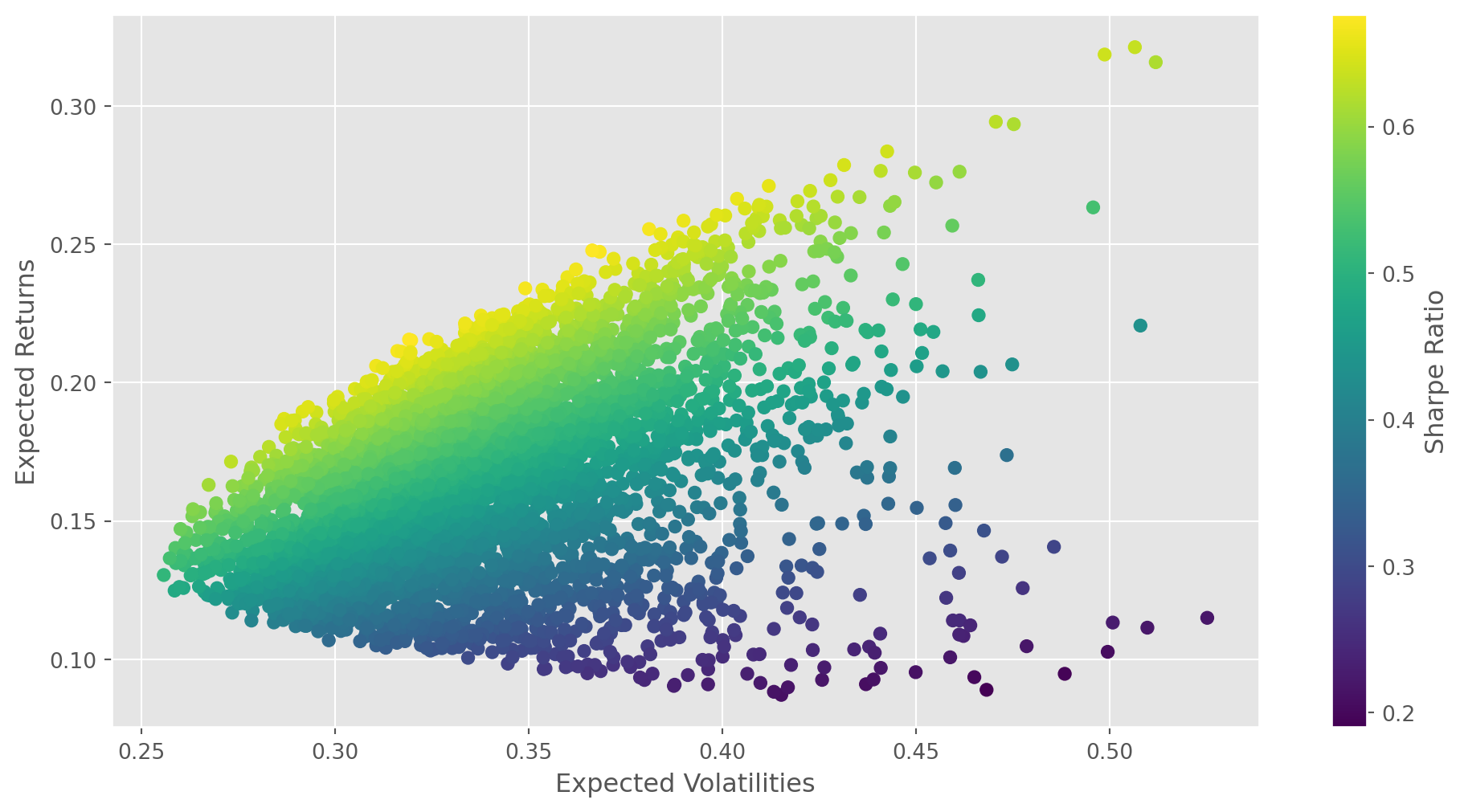
Global Minimum Variance Portfolio
For demonstrating purpose, denote the weight of global minimum variance of \(n\) assets portfolio as \(\mathbf{w}_g=(w_{1,g},w_{2,g},w_{3,g}, ..., w_{n,g})\)
\[ \begin{gathered} \min _{\mathbf{w}} \mathbf{w}^{T} \Sigma \mathbf{w}\\ \text { s.t. } \sum_{i=1}^n w_{i,g}=1 \end{gathered} \]
You can obtain F.O.C by performing partial derivative on the Lagrangian form, however it can be absurdly tedious, therefore we skill this step.
In short, to arrange the F.O.C. in matrix form, we obtain \[ \left[\begin{array}{cc} 2 \boldsymbol{\Sigma} & \mathbf{1} \\ \mathbf{1}^{T} & 0 \end{array}\right]\left[\begin{array}{c} \mathbf{w} \\ \lambda \end{array}\right]=\left[\begin{array}{l} \mathbf{0} \\ 1 \end{array}\right] \]
where \(\boldsymbol{\Sigma}\) is covariance matrix, \(\mathbf{1}\) and \(\mathbf{0}\) is a \(n-1\) vector of \(1\)’s and \(0\)’s.
The solution is straightforward in linear algebra form
\[ \left[\begin{array}{c} \mathbf{w} \\ \lambda \end{array}\right]=\left[\begin{array}{cc} 2 \boldsymbol{\Sigma} & \mathbf{1} \\ \mathbf{1}^{T} & 0 \end{array}\right]^{-1}\left[\begin{array}{l} \mathbf{0} \\ 1 \end{array}\right] \]
Efficient Portfolio
The formulation of portfolio optimization follows a standard microeconomic optimization duality, i.e. maximize the expected return subject to a certain risk, or minimize the risk subject to a certain rate of expected rate.
\[ \begin{aligned} \max _{\mathbf{x}} \mu_p & =\mathbf{w}^{T} \boldsymbol{\mu} \\ \text { s.t. }\mathbf{w}^{T} \boldsymbol{\Sigma} \mathbf{w}&=\sigma_{p, 0}^2 \text { and } \mathbf{w}^{T} \mathbf{1}=1 \end{aligned} \]
\[ \begin{aligned} \min _{\mathbf{w}} \sigma_{p, w}^2 & =\mathbf{w}^{T} \boldsymbol{\Sigma} \mathbf{w} \\ \text { s.t. }\mathbf{w}^{T} \boldsymbol{\mu}&=\mu_{p, 0}, \text { and } \mathbf{w}^{T} \mathbf{1}=1 \end{aligned} \]
where \(\sigma_{p,0}^2\) is the target portfolio variance and \(\mu_{p, 0}\) is the target portfolio expected return.
Theoretically, you can pick any formulation you like, but in practice the latter is more common due to its computational convenience.
The efficient frontier is a graph of \(\mu_p\) and \(\sigma_p\) resembles one side of hyperbola as we have shown above, and is often called the ‘Markowitz Bullet’.
Two constraints for two \(\lambda\)’s, the Lagrangian formulation is \[ L\left(\mathbf{w}, \lambda_1, \lambda_2\right)=\mathbf{w}^{T} \boldsymbol{\Sigma} \mathbf{w}+\lambda_1\left(\mathbf{w}^{T} \boldsymbol{\mu}-\mu_{p, 0}\right)+\lambda_2\left(\mathbf{w}^{T} \mathbf{1}-1\right) \]
The F.O.C.s for a minimum are \[ \begin{aligned} & \frac{\partial L\left(\mathbf{w}, \lambda_1, \lambda_2\right)}{\partial \mathbf{w}}=2 \boldsymbol{\Sigma} \mathbf{w}+\lambda_1 \boldsymbol{\mu}+\lambda_2 \mathbf{1}=\mathbf{0} \\ & \frac{\partial L\left(\mathbf{w}, \lambda_1, \lambda_2\right)}{\partial \lambda_1}=\mathbf{w}^{T} \boldsymbol{\mu}-\mu_{p, 0}=0 \\ & \frac{\partial L\left(\mathbf{w}, \lambda_1, \lambda_2\right)}{\partial \lambda_2}=\mathbf{w}^{T} \mathbf{1}-1=0 . \end{aligned} \]
We can represent the system of linear equations using matrix as \[ \left(\begin{array}{ccc} 2 \boldsymbol{\Sigma} & \boldsymbol{\mu} & \mathbf{1} \\ \boldsymbol{\mu}^{\prime} & 0 & 0 \\ \mathbf{1}^{\prime} & 0 & 0 \end{array}\right)\left(\begin{array}{c} \mathbf{w} \\ \lambda_1 \\ \lambda_2 \end{array}\right)=\left(\begin{array}{c} \mathbf{0} \\ \mu_{p, 0} \\ 1 \end{array}\right) \] or \[ \mathbf{A} \mathbf{z}_w=\mathbf{b}_0, \] where \[ \mathbf{A}=\left(\begin{array}{ccc} 2 \boldsymbol{\Sigma} & \boldsymbol{\mu} & \mathbf{1} \\ \boldsymbol{\mu}^{T} & 0 & 0 \\ \mathbf{1}^{T} & 0 & 0 \end{array}\right), \mathbf{z}_w=\left(\begin{array}{c} \mathbf{w} \\ \lambda_1 \\ \lambda_2 \end{array}\right) \text { and } \mathbf{b}_0=\left(\begin{array}{c} \mathbf{0} \\ \mu_{p, 0} \\ 1 \end{array}\right) \] The solution for \(\mathbf{z}_w\) is then \[ \mathbf{z}_w=\mathbf{A}^{-1} \mathbf{b}_0 \]
Optimization Algorithm
def statistics(weights, returns):
portfolio_returns = np.sum(returns.mean() * weights) * num_trading_days
portfolio_volatilities = np.sqrt(
np.dot(weights, np.dot(returns.cov() * num_trading_days, weights))
)
portfolio_sharpe_ratio = portfolio_returns / portfolio_volatilities
return portfolio_returns, portfolio_volatilities, portfolio_sharpe_ratioIn practice, we could also minimize the negative Sharpe ratio, because \(\text{max} f(x) = \text{min} [-f(x)]\)
def neg_sharpe(weights, returns):
return -statistics(weights, returns)[2] # this is the negative sharpe ratioHere we use lambda function, as a reminder of expression format \[ \text{lambda arguments : expression} \]
def optimize_portfolio(weights, log_returns):
constraints = {"type": "eq", "fun": lambda x: np.sum(x) - 1}
bounds = tuple((0, 1) for i in range(len(stocks)))
return minimize(
fun=neg_sharpe,
x0=weights[0],
args=log_returns,
method="SLSQP",
bounds=bounds,
constraints=constraints,
)def print_optimal_portfolio(optimum, returns):
print(
"Optimal portfolio: ", optimum["x"].round(3)
) # 'x' is the solution array of OptimizeResult object
print(
"Expected return, volatility and SR: ",
statistics(optimum["x"].round(3), returns),
)def plot_optimal_portfolio(optimal, returns, portfolio_returns, portfolio_volatility):
figure, ax = plt.subplots(figsize=(12, 6))
ax.scatter(
portfolio_volatility,
portfolio_returns,
c=portfolio_returns / portfolio_volatility,
)
ax.scatter(
statistics(optimal["x"], returns)[1],
statistics(optimal["x"], returns)[0],
s=100,
marker=(5, 1),
)
ax.set_xlabel("Expected Volatility")
ax.set_ylabel("Expected Returns")
plt.show()optimum = optimize_portfolio(portfolio_weights, log_ret_daily)
print_optimal_portfolio(optimum, log_ret_daily)Optimal portfolio: [0.11 0.524 0. 0.366 0. ]
Expected return, volatility and SR: (0.23183050271279573, 0.3400163438588997, 0.6818216444589528)plot_optimal_portfolio(optimum, log_ret_daily, portfolio_means, portfolio_volatilities)